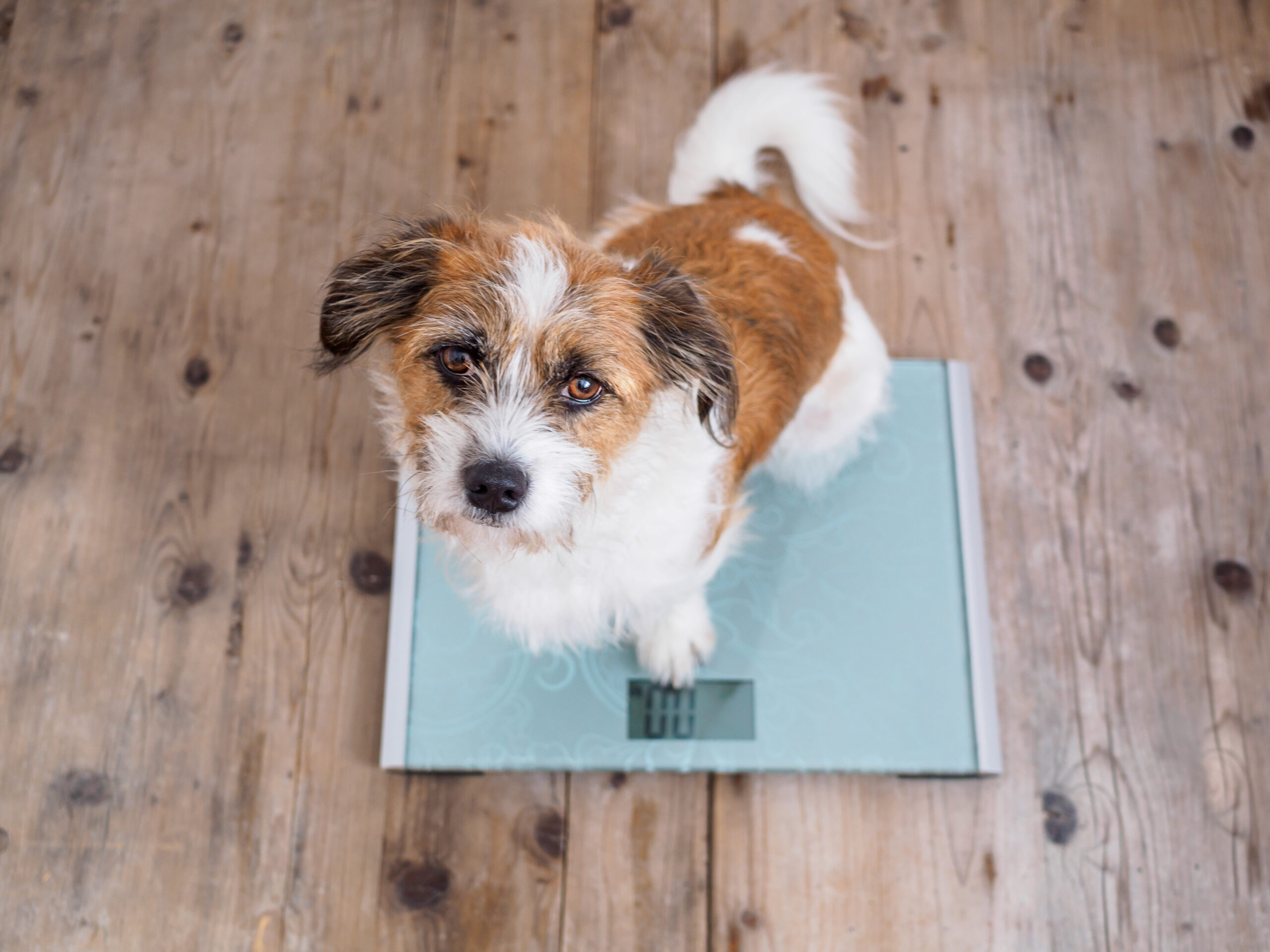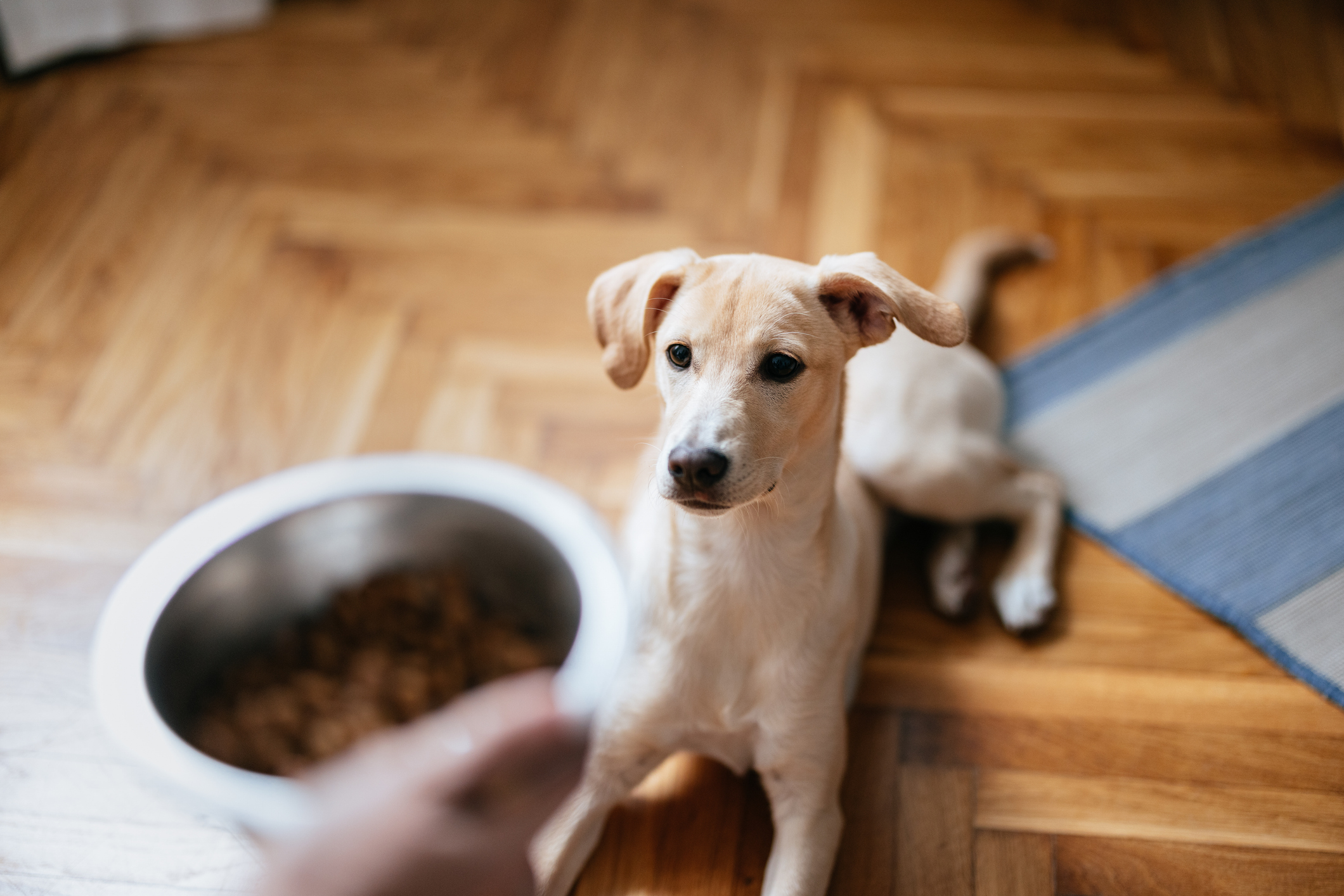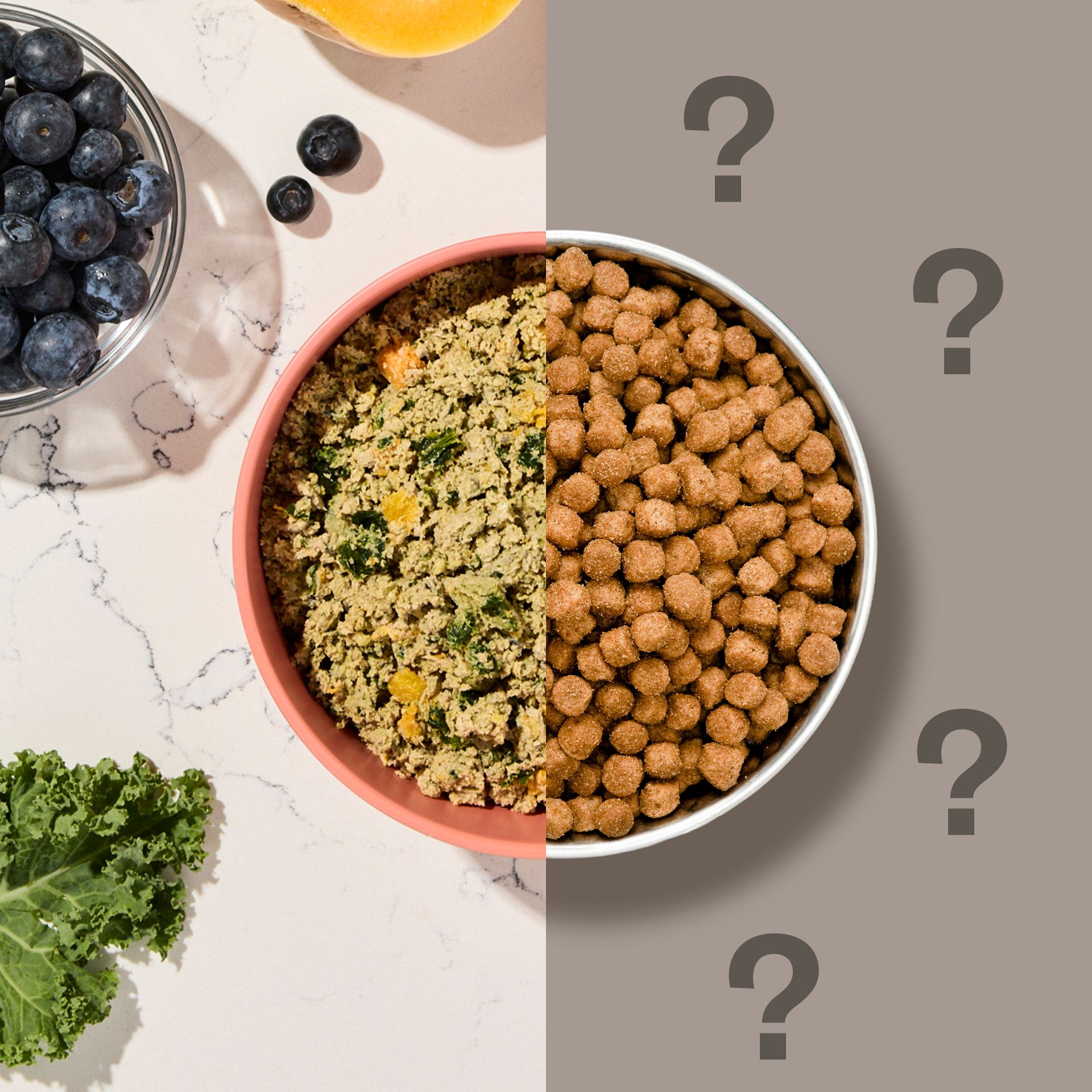Hey Ollie blog readers! We’re offering you an exclusive 60% OFF your starter box! Try now!
A survey conducted in 2018 by the Association for Pet Obesity Prevention found that nearly 56% of dogs in the United States were considered overweight or obese by veterinary professionals, which is a staggering number in light of the health concerns that come with being overweight or obese. As such, early identification of unnecessary weight gain is vital to notice as a pet parent, but how do you know if your dog is overweight? Does it really matter if your dog is a little heavier than it should be?
Why It’s Important for Your Dog to Be a Healthy Weight
Maintaining an ideal body weight can have considerable effects on your pet’s long-term well-being. A 14-year study by Purina found that dogs fed to their ideal body condition lived 1.8 years longer, on average than overweight dogs. Additionally, being overweight can predispose your pet to numerous health problems, including degenerative joint disease (or “arthritis”), pancreatitis, and diabetes mellitus. Overweight dogs also have an increased risk of complications during anesthesia (e.g., during dental cleanings, diagnostic imaging, etc.). In other words, keeping your dog at an ideal body weight grants you more high-quality years with your four-legged family member.

Risks & Health Problems Associated with Overweight Dogs
Being overweight can predispose your dog to many health problems, including the following:
- Arthritis and other joint problems (ex: CCL tears)
- Heart Disease
- Diabetes mellitus
- Shortened Lifespan
- Increased risk of urinary stone formation
- Heart disease
- Collapsing trachea
- Skin infections
- Possible increased risk of some Cancers
- Decreased immune function
- Kidney disease
Ideal Weight Range for Dogs
Identifying an ideal body weight for your dog is crucial. Many people believe that overweight dogs (even those that are just slightly overweight, e.g., BCS of 6 or 7) are at an ideal weight. When (if ever) was the last time your veterinarian told you your dog was at a “perfect weight”? Take note of that. If you have a puppy, you can also use the Waltham Puppy Growth Charts. These charts are a tool that allows you to track your puppy’s growth based on its anticipated adult weight and age. By plotting your puppy’s weight on these charts, their predicted ideal adult weight can be identified when they are only a few months old! Lastly, if neither of these options applies to your dog, the best universal option is to talk with your veterinarian about your dog’s weight, as they are trained to identify overweight pets and determine ideal body weight goals.
Body Condition Scoring for Dogs
While a body weight in pounds or kilograms is a helpful reference point, the best determinant for a dog’s ideal body weight is to use a body condition score (BCS). “BCSing” is often done on a 9-point scale (1-9), with 1 being emaciated, 9 being obese, and 4-5 being an ideal body weight. Veterinarians use a BCS to assess if a dog is underweight, overweight, or at their ideal weight. It is a simple technique that you can also use at home.
Although it is tempting to focus on a dog’s ribs to assess if they are overweight, it is essential to realize that dogs can deposit their body fat in many locations. Body condition scoring takes this into account, as other body regions like the abdomen, hip bones/tail base, chest, and neck can also be storage sites for fat. Some breeds, such as Bulldogs and Dachshunds, may be harder to assess based on their normal breed conformation, while breeds like Great Pyrenees and Pomeranians can also be difficult to assess due to their long hair coats.
How Do You Determine Body Condition Score for Dogs?
Step 1: View your dog from the side and from above
See if they have a nice, well-defined abdominal tuck when viewed from the top and the side. Pets that are overweight will often appear “straight” or “bulging” in the area between their ribs and their hip bones, which indicates excessive body fat in this region.
Step 2: Find their ribs
Next, you will want to gently slide your hands over your dog’s ribs, ideally feeling them with very light pressure. If you can feel a small amount of soft or “spongy” tissue between your fingers and your dog’s ribs, that’s perfect! Overweight dogs will often have extra fat over this area, requiring you to apply more pressure to feel their ribs.
Step 3: Assess your dog’s hip bones and lower back bones
These bones should be minimally prominent—but still felt—when gently sliding your hand over them.
Step 4: Asses the neck & chest
Also assess their chest and neck region, which should be firm and muscular rather than soft and floppy.
Suppose you see the aforementioned abdominal tuck, a light layer of fat over the ribs, minimally prominent hip/lower back bones, and well-defined chest and neck region. In that case, you can feel confident that your dog is an ideal weight. If you need to apply a little extra pressure to feel those ribs and hip bones, or if you feel like your dog’s abdomen looks more like a straight line than a well-defined tuck, it is likely your dog is a bit overweight.
If this all seems like a lot of information to remember, don’t worry! BCS charts, such as those from the World Small Animal Veterinary Association (WSAVA), are a great resource to have on hand whenever you BCS your dog to ensure you are on the right track.

Factors Affecting Your Dog’s Weight
When trying to prevent or reverse weight gain, think about your pet’s daily life and routine. Some important lifestyle factors to consider include the following:
Is your dog spayed or neutered?
Removing a dog’s testes or ovaries takes away a significant metabolic demand on their bodies. Because of this, their everyday energy needs will decrease by ~20% following a spay/neuter procedure.
Additionally, spaying a dog removes the influence of estrogen, a hormone that is known to reduce appetite. Spaying a dog reduces the estrogen in her body, so the appetite suppression is reversed, leading to increased appetite and a risk for weight gain.
Is your dog fed meals or freely given food?
Dogs that are “free-choice” fed, or who always have food available to them, are more likely to overeat and gain weight than dogs fed appropriately portioned meals.
How many treats does your dog get?
Excessive treats or sharing of table scraps with your dog can provide more calories than they need while potentially posing a health risk by unbalancing their diet.
Aim for your dog to eat no more than 10% of their daily calories in treats.
How old is your dog?
Middle-aged and senior dogs are more likely to be overweight than younger dogs, as they have had more time to accumulate excessive weight.
Additionally, aging dogs may develop joint problems, which can limit their activity and ability to burn calories, thereby making it easier for them to gain weight.
How active is your dog?
Dogs that are minimally active or live exclusively indoors expend less energy than more active dogs during the day. As such, it is easier for them to gain weight by burning fewer calories in their daily life.
What breed is your dog?
Some breeds, such as Labrador Retrievers, Dachshunds, West Highland Terriers, and Cavalier King Charles Spaniels, seem predisposed to obesity.
Continue Learning: Dog Breeds Prone to Weight Gain
Overfeeding Does Not Equal Love
In addition to these lifestyle factors, another tough yet important lesson for pet parents is that sharing food with your dog is not always the best way to show your love for them. Many pet parents will see their dog approach them and assume that they are hungry; however, it is not uncommon for dogs to seek their owner’s attention or playtime in a similar manner. By providing treats to try and appease their dog, a pet parent unintentionally misses what their pet is ultimately asking for, while also providing excessive calories, leading to weight gain. Instead of offering treats, consider tossing a ball, playing with a toy, or spending time with your dog to help strengthen your bond and keep your dog’s best interests at heart.

How to Help Your Dog Lose Weight
Helping your dog reach an ideal weight can seem daunting, but it can be achieved through small lifestyle changes consistently practiced over a long period of time. When a dog is overweight, the problem is often caused by a combination of excessive treat/table scrap intake and inactivity. Finding ways to keep your dog mentally and physically stimulated, such as feeding puzzles and play time, can be great ways to help fight boredom, burn extra calories, and serve as a great alternative to treats! Additionally, it is important to limit treat calories to no more than 10% of your dog’s total daily caloric intake. Swapping out energy-dense treats for foods like fruits and vegetables can easily reduce your dog’s treat calories. If you need help calculating your dog’s daily calorie needs, see Table 1 below, or talk to your family veterinarian for more details.
Dietary Adjustments
It can be tempting to help your dog lose weight by simply reducing the amount of their regular diet. However, if they’re overweight due to eating too many treats, reducing their normal diet will further unbalance their diet and potentially lead to nutrient deficiencies. First, reduce the number of treats/table scraps your dog eats to no more than 10% of their total calorie intake. If you don’t see success, then you can look at modifying the portions of their regular diet. To determine how much your dog should eat, see Table 1 below, or talk to your family veterinarian for further assistance.
Table 1: Calculation of Resting Energy Requirement (RER) Based on Body Weight
| Ideal weight (lbs) | Calories (kcal) needed at 100% RER per day | Ideal weight (lbs) | Calories (kcal) needed at 100% RER per day |
|---|---|---|---|
| 10 | 218 | 70 | 938 |
| 15 | 295 | 75 | 988 |
| 20 | 366 | 80 | 1037 |
| 25 | 433 | 85 | 1085 |
| 30 | 497 | 90 | 1132 |
| 35 | 558 | 95 | 1179 |
| 40 | 616 | 100 | 1225 |
| 45 | 673 | 105 | 1271 |
| 50 | 729 | 110 | 1316 |
| 55 | 783 | 115 | 1361 |
| 60 | 835 | 120 | 1405 |
| 65 | 887 | 125 | 1449 |
It is important to feed your dog at least the amount listed in Table 1, as many over-the-counter dog diets are not meant to be fed at a lesser level than this and can lead to nutrient deficiencies if underfed.
Calorie content can be found on any dog food by looking on the back of a bag or can and reading the fine print to locate a “kcal/cup”, “kcal/can”, or “kcal/oz” measurement. From that information, divide the number in the table by this kcal/cup or can amount to find how many cups, cans, or ounces to feed per day. Remember, as well, that a cup refers to a standard 8 oz measuring cup, so be sure to use one when weighing out your dog’s food!
In some instances, a veterinarian may recommend that you change your dog’s diet to help achieve weight loss. This can include using a veterinary prescription weight loss diet or using a canned/fresh pet food, as these can contain a higher moisture content and take up more space in a dog’s stomach, helping them to feel full while eating fewer calories. This is a decision that should be made in coordination with your dog’s veterinarian, so be sure to speak with them before making any changes to your dog’s diet.


Healthier ingredients,
tailored recipes, delivered
Get 50% of your first box of Ollie’s fresh
delivered meals today!
How Switching to Ollie Dog Food Helped Minnie Lose 20lb
Exercise Routines
Exercise can be a great way to help your dog burn calories while providing a fun experience for you and your dog to enjoy together. However, it is important to not start off too intensely with exercise, especially for dogs that have previously led sedentary lives. Some fun examples include walking leisurely, going up and down stairs a few times, or playing a light round of fetch. These are by no means the only options, and many more fun activities can be found here. Be sure to pay close attention to your dog, and let them dictate the activity level. If they are exhausted quickly, that is okay. The goal is to promote fun activity while not pushing your dog too hard too quickly which can lead to injuries.
A reasonable starting point for exercise may be 10-15 minutes per day of a low-intensity exercise. As time goes on and your dog is losing weight and improving their fitness, you may be able to increase this to 30 minutes, 45 minutes, or even an hour or two, depending on your dog’s desired activity level and fitness. Remember, not every dog needs to be a superstar athlete, and whatever activity level works best for your dog’s health and happiness—and your lifestyle—is ultimately the best program to implement.
Exercise Ideas for Dogs of All Ages
Helping Senior Dogs Lose Weight
Helping a senior dog lose weight can seem like an uphill battle, as many senior pets are impacted by joint disease, low activity levels, and systemic diseases. It is important to be patient and understanding with senior dogs when trying to help them lose weight, as exercise may not be a reasonable option for them if they are in pain or have trouble moving around. In these instances, work with a veterinarian who may consider changing your senior dog’s diet to help with weight loss while preserving healthy muscle mass and maintaining overall quality of life.
A Healthy Diet Can Help Your Dog Live a Fuller Life
Keep a close eye on your dog’s body composition and weight to ensure that they aren’t becoming overweight, as this can have serious health consequences. Be sure to watch how many treats your dog eats, and feed them a well-portioned, high-quality dog food. These steps, combined with keeping them active, will help them put their best paw forward. If you think your dog might be overweight or at risk of becoming so, don’t worry! By feeding them a good diet at the right amount, you can give your dog the best chance to live a long, healthy life. The Ollie blog is devoted to helping pet parents lead healthier lives with their pups.
Get a custom meal plan tailored to your dog’s needs with Ollie.
Tagged As:

The nutrition your dog needs,
the food they want.

Enjoying our articles? Subscribe our Newsletters and get new articles directly to your inbox
You might also like
12 August 2025
5 MINS READ
Top 8 Allergens Hiding in Your Dog’s Bowl
As pup parents, we never want to see our dogs uncomfortable. When it comes to itching, swelling, and upset stomachs, the culprit may be in their bowl. Understanding the most common allergens and t…
by Ollie Pets
11 August 2025
5 MINS READ
Not all Processing Is Equal: What’s Really in Your Pet’s Bowl?
As pet parents, we know how important it is that our dogs live long, healthy, and happy lives. This is why at Ollie, we focus so much on what goes into their bowls. But did you know there may be s…
31 July 2025
4 MINS READ
The Healthiest US States for Dogs
The Ollie Health team, a team of veterinarians and veterinary technicians, reviews thousands of photos submitted through Ollie’s Health Screening service. That’s hundreds of dogs (and their st…
by Ollie Pets







